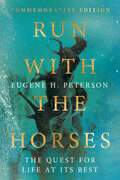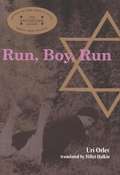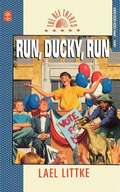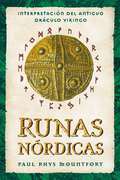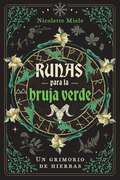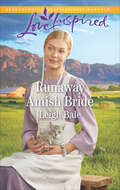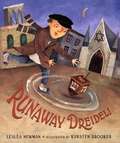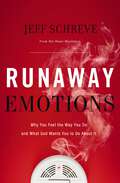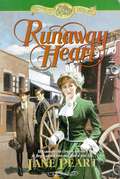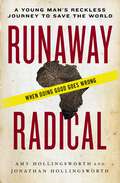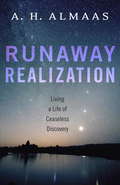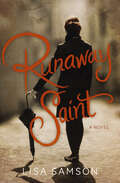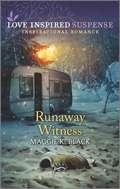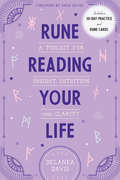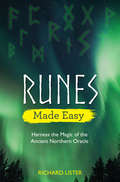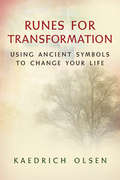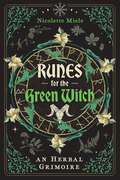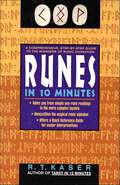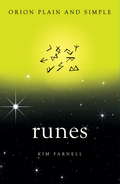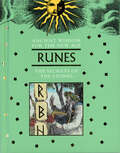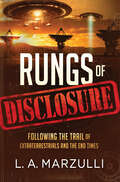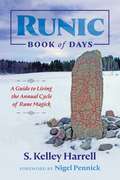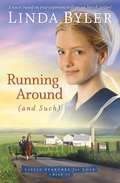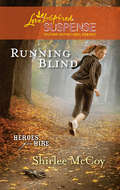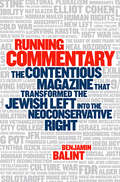- Table View
- List View
Run with the Horses: The Quest for Life at Its Best
by Eugene H. PetersonIn Jeremiah 12:5 God says to the prophet, "If you're worn out in this footrace with men, what makes you think you can race against horses?" We all long to live life at its best—to fuse freedom and spontaneity with purpose and meaning. Why then do we often find our lives so humdrum, so unadventuresome, so routine? Or else so frantic, so full of activity, but still devoid of fulfillment? How do we learn to risk, to trust, to pursue wholeness and excellence—to run with the horses instead of shuffling along with the crowd? In a series of profound reflections on the life of Jeremiah the prophet, Eugene Peterson explores the heart of what it means to be fully and genuinely human. In his signature pastoral style, he invites readers to grasp the biblical truth that each person's story of faith is completely original. Peterson's writing is filled with humor and self-reflection, insight and wisdom, helping to set a course for others in the quest for life at its best. This special commemorative edition includes a new preface taken from Eric Peterson's homily at his father's memorial service, as well as a six-session Bible study guide for individuals or groups.
Run, Boy, Run
by Uri Orlev"'Srulik, there's no time. I want you to remember what I'm going to tell you. You have to stay alive. You have to! Get someone to teach you how to act like a Christian, how to cross yourself and pray. . . . The most important thing, Srulik,' he said, talking fast, 'is to forget your name. Wipe it from your memory. . . . But even if you forget everything-even if you forget me and Mama-never forget that you're a Jew.'"And so, at only eight years old, Srulik Frydman says goodbye to his father for the last time and becomes Jurek Staniak, an orphan on the run in the Polish countryside at the height of the Holocaust. With the danger of capture by German soldiers ever-present, Jurek must fight against starvation, the punishing Polish winters, and widespread anti-Semitism as he desperately searches for refuge. Told with the unflinching honesty and unique perspective of such a young child, Run, Boy, Run is the extraordinary account of one boy's struggle to stay alive in the face of almost insurmountable odds-a story all the more incredible because it is true.
Run, Ducky, Run (Bee There #6)
by Lael LittkeDucky wants to be seventh-grade class president, but she fears that winning against another club member may cause her to lose her friends. When Paula “Powerhouse” Powell invites Ducky to run for seventh-grade class president, Ducky likes the idea. But the day after she agrees to let Paula be her campaign manager, she finds out that Marybeth is going to run! Will the Bee Theres--her new friends in her Beehive class--still want her to be one of them when they hear about her candidacy? It’s too late to back out of the race, but maybe, just maybe, she can do something to make sure she loses. With the help of Anton, her big brother; Dermott, her obnoxious little cousin; Jamahl, her handsome but shy friend; and Gruff the Goat, Ducky embarks on the craziest campaign ever! Read more about the adventures of a club of 12 and 13 year old girls in middle school who act allot like you as they cope with crushes, jealousy, wanting to belong, being teased, loyalty, and more. Look for these books in the Bee Theres series including #1. Getting Rid of Rhoda, #2. The Mystery of Ruby's ghost, #4. There's A Snake at Girl's Camp, #5. The Bridesmaids' Dress and #7. The Phantom Fair.
Runas nórdicas: Interpretación del antiguo oráculo vikingo
by Paul Rhys Mountfort• Revela el simbolismo y el significado adivinatorio de los 24 &“pentagramas&” rúnicos • Proporciona instrucciones claras sobre cómo fabricar tus propias piedras rúnicas • Explica el papel de las runas en la tradición de la sabiduría nórdica y su influencia en obras como El señor de los anillos de Tolkien Las runas nórdicas son un sistema mágico potente y profundamente transformador que brinda a los lectores contemporáneos acceso a la antigua tradición de las culturas del norte de Europa. Las runas tienen profundas resonancias dentro del mundo nórdico pagano, de diosas y dioses, gigantes, enanos, guerreros y magos, que han influido mucho en el trabajo de J. R. R. Tolkien, entre otros. La tradición nórdica atribuye el descubrimiento de las runas al &“padre de todo&”, Odín, un dios de la inspiración y la sabiduría secreta, además de prototipo mítico de los magos rúnicos, quienes establecieron el patrón para obtener su conocimiento.Runas nórdicas aborda tres áreas principales: su tradición, la historia de este oráculo nórdico de 2.000 años de antigüedad; sus pentagramas, el significado de cada runa del antiguo alfabeto futhark y sus poderosas lecciones mitológicas, mágicas y prácticas para la vida diaria; y su tirada, una guía completa para la aplicación oracular de las antiguas runas, incluida su elaboración, adivinación y autodesarrollo. Como muestra este libro, las runas, más que reflejar el camino del destino, ayudan a desarrollar y mejorar nuestra intuición. Mientras aprende a lanzar e interpretar las runas, el lector se volverá receptivo a las corrientes de energía en la realidad material y se fortalecerá en las artes de su transformación.
Runas para la bruja verde: Un grimorio de hierbas
by Nicolette Miele• Examina las conexiones entre hierbas y plantas de cada una de las 24 runas del futhark antiguo, así como las correspondencias con deidades, astrología, tarot y cristales• Proporciona ejemplos y consejos sobre cómo se pueden combinar runas y plantas en hechizos y rituales para manifestar, proteger, curar, desterrar y más• Explica cómo se puede trabajar con runas y plantas para el proceso conmovedor de reconstruir y conectarse con la madre naturalezaEn este grimorio mágico, la bruja herbolaria Nicolette Miele sumerge a los lectores en la sabiduría y el folclore de las 24 runas del futhark antiguo, así como en sus correspondencias con deidades, astrología, tarot, cristales y plantas. Cada capítulo abre discutiendo la etimología, significados, mitología, adivinación, correspondencias y magia de una runa en particular y cierra con perfiles de varias hierbas y plantas que poseen energías mágicas similares. El perfil de cada planta profundiza en sus aplicaciones mágicas, metafísicas, tradicionales y medicinales, además en la manera de trabajar con estas increíbles plantas aliadas.Por ejemplo, la autora conecta fehu, la runa de la riqueza y valor, con la práctica de construir altares, hacer ofrendas, y con la alfalfa, el cedro, el diente de león y otras plantas utilizadas tradicionalmente en la magia de la abundancia y prosperidad. En el capítulo sobre kenaz, la runa del calor y la iluminación, la conexión con la naturaleza se nutre a través del elemento fuego y un ritual con velas bindrune. Las plantas relacionadas con kenaz son aquellas que encarnan las características del fuego, como la pasión, la ferocidad y la sexualidad, e incluyen el clavo, la damiana y la kava kava.Al guiar a la bruja verde a través de los beneficios y fortalezas de la magia sinérgica, este libro ayuda a los practicantes de magia ecléctica a avanzar en su oficio a través de la magia y la medicina popular, rituales, meditaciones, hechizos y el proceso conmovedor de renaturalización y conectarse con la Madre Naturaleza.
Runaway Amish Bride: Runaway Amish Bride Amish Country Amnesia (Colorado Amish Courtships #1)
by Leigh BaleIn this Amish romance series debut, a stubborn widower is unwilling to remarry—even as his bride arrives at his home!Widower Jakob Fisher isn’t interested in remarrying, even to pretty Abigail Miller. But thanks to his daed’s meddling, Abby’s sitting in his Colorado farmhouse, expecting to be wed. While Jakob can’t offer marriage, he can give Abby a job caring for his young children. But with her graceful ways, and the happiness she brings to the little ones, Jakob soon finds himself falling for her. Could Abby make Jakob’s familye happy and whole once again?
Runaway Dreidel!
by Lesléa Newman"In this rhyming tale in the style of "The Night Before Christmas," a family's preparations for Chanukah are disrupted by a wildly spinning dreidel." There was holiday hustling and bustling galore. Papa was shining the silver menorah, Mama was wrapping a gift for Aunt Dora." A delightful introduction to the customs of Hanukkah.
Runaway Emotions: Why You Feel the Way You Do and What God Wants You to Do About It
by Jeff SchreveIf we pay attention to the alarms in our lives, they could save us.Worry. Anger. Loneliness. Negative emotions are uncomfortable by design. Like any good fire alarm, they alert us to a greater danger. But they won't help us if we try to cover them up, hide them behind excuses, or assume they will always plague us.The only healthy way to manage negative emotions is to find their source and address the problem that set them off. As pastor Jeff Schreve says, "A specific and compelling message can be found in each of your negative, painful emotions. God Himself is trying to speak to you through those emotions--right now."So what is God saying? How can we understand our emotions--even change them? Schreve shows how the truth of the Bible can make sense of our confusion. The power of the Holy Spirit can lead us to freedom, and Jesus Christ can give us true peace in the midst of any crisis.You don't have to let your emotions run away with you, your family, or your future.
Runaway Heart (Westward Dreams #1)
by Jane Peart"End of the line!" The stagecoach driver's shout sent a chill down Holly Lambeth's spine. What an ominous sound! Was Riverbend, Oregon, to be the end of the line for her? She had come West to escape the swirling gossip about her broken engagement. She had come to escape the humiliation of being jilted. She came here to find a welcome new life, but her cousin's chilly reception tells her she has made a terrible mistake. Here in Riverbend, 2,000 miles from Kentucky, in a town barely more than a mining camp, Holly faces the fact that she is unwanted and unwelcome. Knowing this unhappy truth, Holly reaches another conclusion. Only she can change her situation. Both the sophisticated editor of the local newspaper, as well as the town's dedicated doctor, are attracted to the pretty newcomer. But Holly has more than romance on her mind. An unforeseen opportunity presents a challenge that brings Holly to a decision that will not only change her, but alter her own vision of her future.
Runaway Radical: A Young Man's Reckless Journey to Save the World
by Amy Hollingsworth Jonathan HollingsworthTravel the world, change lives, save souls. (Note: Results not typical.)A young idealist heeds the call to radical obedience, gives away all of his belongings and shaking off the fetters of a complacent life, travels halfway around the world. There he discovers, among the poor and the fatherless of West Africa, that he has only surrendered to a new kind of captivity.There is no doubt that young people today are fully invested in social and human rights issues. They start their own nonprofits, they run their own charities, they raise money for worthy causes. Books on saving the world abound, topping the bestsellers' lists, fueling the drive to prove not only commitment to the world but devotion to God.Now there is a new crop of books starting to emerge, detailing the consequences of trying to save a world that is not ours to save. But none of these books tell the story thatRunaway Radical tells; this is the first book to highlight the painful personal consequences of the new radicalism, documenting in heartbreaking detail what happens when a young person becomes entrapped instead of liberated by its call. His radical resolve now shaken, he returns home to rebuild his life and his faith.Runaway Radical serves as an important and cautionary tale for all who lead and participate in compassion activism, in the art of doing good-- both overseas and at home-- amidst this new culture of radical Christian service.
Runaway Realization
by A. H. AlmaasFor the first time in print, well-known spiritual teacher A. H. Almaas presents the highest level and most profound teachings of the Diamond Approach on the true nature of reality and the path to enlightenment. The teaching in this book is off the map--because reality itself cannot be captured in a map. In fact, reality is far more alive, far more mysterious than anything we can conceive of. It is always revealing itself by knowing itself; and knowing reality and living it becomes the fulfillment of our life. A. H. Almaas, the originator of the Diamond Approach, here presents a new paradigm for understanding reality: the view of totality. He reveals that our life can become an endless revelation of reality, an adventure with neither beginning nor end. A. H. Almaas has been developing and teaching the Diamond Approach, a spiritual path of self-realization and maturity based on an original synthesis of modern discoveries in the field of psychology and a new paradigm about spiritual nature, for more than thirty years. If we can say the Diamond Approach has a goal it is to realize the truth at progressively deeper levels until one reaches the ultimate Truth, the Absolute, and to become integrated into that truth so that we are a living presence and embodiment of that truth. The teachings of this path have been unfolding over time, and Runaway Realization presents--for the first time in print--the highest level of teachings in the Diamond Approach in the most profound work by Almaas so far. In this book, Almaas offers a detailed look at the true nature of reality and the nature of enlightenment. He also talks about practice--what it is and what it isn't, and how practice relates to the process of realization. He looks at what it is to be a human being and what our role is in the totality of the universe. The material includes a discussion of the nature of space and time, as well as a view of more and more subtle levels of realization.
Runaway Saint: A Novel
by Lisa SamsonWhen her aunt shows up homeless on her doorstep, Sara suspects anything but a miracle.Sara’s an artist with a supportive husband and a house that folks on her block admire outright. But she’s restless and bored with life.Then her legendary Aunt Bel shows up, wearing a smile after years without a word.Twenty years ago, fresh out of college, Bel left for a summer missions trip and never returned. Now she’s on Sara’s doorstep, looking for a place to crash. Sara can’t say no to family, even if she hasn’t seen Bel since she was a nine-year-old girl. But saying yes to Bel turns Sara’s whole precariously-balanced life upside down.The enigmatic Bel gives Sara’s family and their community a jolt of fresh thinking and clarity.But Bel is hiding something. Though she won’t talk about it, Sara soon learns that Bel has been through a hellish ordeal. And she has the burn marks to prove it."[Samson's] gift for creating unique, flawed character elevates this book above others. Each line has so much truth, and readers will likely ponder different passages long after finishing." —Romantic Times Review, TOP PICK! 4 1/2 stars"Samson’s quirky characters will have readers laughing, crying, and shaking their heads in disbelief, sometimes all at the same time. This uplifting read . . . will attract fans of women’s fiction and especially works by authors Sarah Jio, Anne Tyler, and Alice Hoffman." —Library Journal
Runaway Witness (Protected Identities)
by Maggie K. BlackThere is no safe place—not even in witness protection.On the run after her witness protection location is exposed, Iris James trusts nobody—until the return of an undercover detective she thought was dead. Mack Gray was once Iris’s protector—and the man she was falling for—but he was forced to fake his death and go into hiding. Now with a killer’s henchmen on their trail, can he keep her alive long enough to testify?Protected Identities
Rune Reading Your Life: A Toolkit for Insight, Intuition, and Clarity
by Delanea DavisLearn the ancient art of reading runes to inspire, empower, and jumpstart your journey to self-discovery and fulfillmentReveal the wisdom of the runes--24 Norse symbols--to connect with your true self, master the art of being present, and fearlessly welcome your future's unfolding. Like pulling an angel card, consulting a horoscope, or reading tarot, choosing runes with a question or intention in mind allows us to draw on the divinatory magic of these ancient symbols. We can make space for dialogue with our inner selves, convert intentions into actions, and open ourselves to being more aware and awake than we ever thought possible. This approachable, accessible, and empowering introduction to the runes shows you how. In three practical sections, Rune Reading Your Life provides an introduction to the 24 runic symbols and their history, explains their ancient meanings, and reveals their modern interpretations. It guides you on a 30- day transformational rune reading practice, showing how to interpret and apply runic wisdom to everyday life. Also included are removable rune cards that readers can use to begin their practice immediately.
Runes Made Easy: Harness the Magic of the Ancient Northern Oracle
by Richard ListerA new addition to the Made Easy series, this book will teach readers about the ancient power of Northern traditions, the runes and their magic.This is your key to unlocking the ancient power and wisdom of the runes and their magic. Learn how to use them for divination, guidance and more.The runes are some of the most powerful tools available to you. They are more than just a method of words and writing: each rune has a phonetic sound, similar to the sounds heard in Norwegian or Icelandic. They were used to communicate, for divination, to provide guidance and were also bound together to make magic spells.In this insightful, practical book, Rich Lister will provide you with a resource that you can use to build your knowledge and develop your own relationship with the runes. In Runes Made Easy, you will discover: • an introduction to Norse mythology and the role of the runes within it • how to use and work with each rune • how to make your own set of runes, which materials to use and how the material you choose impacts the energy and resonance of the runes • the characteristics and meaning of each of the 24 Elder Furtharc runes • how to set an intention for your rune useThe runes, if used and treated with respect and honour, provide a support system and life-navigation tool. When you learn how to use them, you'll receive the guidance and answers you've been looking for.'Rich is the real deal. He's a Viking warrior with a healing heart and soul.' - Kyle Gray, bestselling author of Raise Your Vibration
Runes for Transformation
by Kaedrich OlsenRunes have long been used as vital tools for transformation. The Norse employed them as tools for communication, and the Vikings would use them as wisdom before embarking on a journey or entering battle. Runic scholar Kaedrich Olsen reclaims the transformative power of the runes for readers today as a key to unlocking our potential for personal growth and our life's vision. Runes for Transformation is unlike any other rune book on the market, with Olsen's unique techniques and applications for this ancient alphabet including affirmations, NLP, visualizations, and meditation, as well as the historical background essential to embarking on this path.A highly respected teacher and transpersonal path worker, Kaedrich Olsen posits that the time for this "deeper working" of the runes has come and this will aid readers in both personal and collective evolution. Runes for Transformation is a rich resource and excellent guide for readers to take the steps to change their lives with a boldly modern approach to the ancient runes and for "change that really matters."
Runes for the Green Witch: An Herbal Grimoire
by Nicolette MieleA magickal guide to working with runes and plant allies for manifestation, healing, and spellwork• Examines the herb and plant connections of each of the 24 runes of the Elder Futhark as well as correspondences with deities, astrology, tarot, and crystals • Provide examples and tips on how runes and plants may be combined within spells and ritual for manifesting, protecting, healing, banishing, and more • Explains how runes and plants can be worked with for the soulful process of rewilding and connecting with Mother Nature Runes and plants both contain the dynamic and raw energies of Mother Earth and can be used to heal, manifest, protect, and elevate magick. Both support and deepen the nature-human connection that is vital to mind, body, and spirit. And while both can provide us with many benefits on their own, when merged in magickal union, their combined powers are multiplied exponentially. In this magickal grimoire, herbalist witch Nicolette Miele immerses readers in the wisdom and folklore of the 24 Elder Futhark runes as well as their correspondences with deities, astrology, tarot, crystals, and plants. Each chapter begins by discussing the etymology, meanings, mythology, divination, correspondences, and magick of a particular rune and culminates with profiles of several herbs and plants that possess similar magickal energies. Each plant profile delves into the magickal, metaphysical, traditional, and medicinal applications as well as how to work with these incredible plant allies. These profiles also provide examples and tips on how the runes and plants may be combined within spells and ritual for manifesting, protecting, healing, banishing, and more. For example, the author connects Fehu, the rune of wealth and value, with the practice of altar-building, making offerings, and with alfalfa, cedar, dandelion, and other plants traditionally used in abundance and prosperity magick. In the chapter on Kenaz, the rune of heat and illumination, the nature connection is nurtured through the element of fire and a step-by-step bindrune candle ritual. The plants connected with Kenaz are those that embody the characteristics of fire—such as passion, ferocity, and sexuality—and include clove, damiana, and kava kava. Guiding the green witch through the benefits and strengths of synergistic magick, this book helps eclectic magickal practitioners advance their craft through folk magick and medicine, rituals, meditations, spells, and the soulful process of rewilding and connecting with Mother Nature.
Runes in Ten Minutes
by Richard T. KaserRunic divination is a method that is more than 2,000 years old, yet rune stone sets are available today in New Age stores. For readers who do not have their own rune stones, Kaser shows how to create your own, as well as how to substitute Scrabble titles for traditional runes. From the successful author of Tarot in Ten Minutes.
Runes, Orion Plain and Simple: The Only Book You'll Ever Need (Plain and Simple)
by Kim FarnellA practical guide on how to make your own set of runes and how to interpret them.Runes are alphabet letters or characters that have been used for thousands of years as a form of communication and divination. This book, written by an authority on divination systems, shows readers how to make their own set of runes and how to interpret them.Topics covered include:· A brief overview of runes, from Etruscan times to the present· A summary of the myths and lore that inform runic wisdom· Definitions of the basic rune symbols· Instructions on how to read the runes and rune spreads· An introduction to runic magicIn the past 25 years using runes as a divination tool has become increasingly popular. This accessible guide presents each letter of the runic alphabet in detail with its origins and magical uses and helps seekers tap into their energy. From making your own runes (and a bag to protect them) to reading the ancient alphabet, casting the runes and interpreting the spread, all the basics are laid out in a clear, easy-to-follow and superbly illustrated fashion which is perfect for beginners.
Runes: The Secrets of the Stones (Ancient Wisdom for the New Age)
by Anders AnderssonThis introductory guide to runic divination reveals how to use these ancient symbols to gain valuable insight. The runic alphabet of ancient Nordic and Germanic peoples has long been understood to possess hidden magic. Medieval mystics accessed this power through a divination system using runic symbols inscribed on small stones or tiles. This book reveals the secrets of rune casting, with instruction on how to read the runes for love, meditation, inner wisdom, health, and prosperity. With full explanations of runic alphabets and groupings, you will be able to create your own personalized set of runes, learn the most effective methods for casting, and try a variety of readings. This volume also explains the connection between runes and gems, and includes dozens of accompanying paintings and photographs.
Rungs of Disclosure: Following the Trail of Extraterrestrials and the End Times
by L. A. MarzulliIs this the coming Great Deception? By the end of this book, you will reveal the truth about extraterrestrial presences on earth—that they are real, burgeoning, and not going away. You also will understand what the Biblical perspective on this phenomenon is and is not. They&’ve been here for thousands of years, making their presence known in the shadows. They might be seen by a lonely motorist on a deserted road late at night or by a frightened and confused husband in the bedroom he is sharing with his wife. Perhaps the most disconcerting part of this phenomenon boils down to this question: Has the government been aware of their presence all along and is covertly working with them toward some secret end? In Rungs of Disclosure, what once was fringe is now reality! While reading, you&’ll meet regular people—just like you—who have encountered something beyond their ability to explain. You&’ll also hear from people of great faith and deep religious belief who continue to have these strange and deeply unsettling encounters. L. A. Marzulli explores these ongoing incidents to discover the answers to these questions: Who are &“they&”? What do they want? And why are they here? Can you handle the truth? Read this book—if you dare.
Runic Book of Days: A Guide to Living the Annual Cycle of Rune Magick
by Nigel Pennick S. Kelley HarrellA step-by-step guide to working with the runes throughout the year • Explains how the 24 runes of the Elder Futhark each rule the calendar for a half-month • Details the runes most powerful during each runic half-month, what they portend for personal and spiritual wellbeing, and techniques for creating relationships with them • Includes structured devotionals for each half-month and runic initiation rituals for the 8 pagan Sabbats, or holy days, such as the Summer Solstice (Litha) and Lughnssadh (the first harvest holy day) The Old Norse runes, known as the Elder Futhark, have long joined forces with the cycles of the seasons to offer powerful initiations, guidance, and wisdom. Aligning the sacred festivals, plantings, and harvests of ancient runic calendars with our modern 12-month calendar, Kelley Harrell reveals how the runes can once again offer initiations as well as instruct us on the holy days and creative rhythms of today. Drawing on her more than 25 years of shamanic practice and runic study, Harrell offers a step-by-step primer to work with the runes throughout the year. She explains how the 24 runes of the Elder Futhark follow a seasonal progression in which each stave rules the calendar for a half-month. She explores the meaning of each rune in detail and presents structured runic devotionals for each half-month, interwoven with guidance on how to make the best use of the life force available during each season, as well as runic initiation rituals for the 8 pagan Sabbats, or holy days, such as the Summer Solstice (Litha) and Beltane (May Day). She details the runes most powerful during each half-month, what they portend for personal and spiritual wellbeing, techniques for creating relationships with them, and how to work with them as an oracle. The author also explains how the runes leading up to each Sabbat help create the space for properly greeting each calendrical transition and completing its initiation. By moving through Nature’s cycle with the runes, each year becomes a reliable and trackable process of personalized growth and spiritual connection. Progressing through the teachings of each stave while honoring the seasons, Harrell’s year with the runes becomes an initiation into a direct relationship with powers of Nature.
Running Around (and Such): A Novel Based On True Experiences From An Amish Writer!
by Linda BylerA romance novel by an Amish writer, based on true experiences! It isn't that Lizzie doesn't want to stay Amish. It's just that there is so much to figure out. Like why can't she let her hair a little looser on top? And why can't she wear shoes with a little bit more of a heel? And will she ever really just know for a fact who she is going to marry like her next-older sister, Emma, does? And how does it happen that her just-younger sister, Mandy, is going on a date before Lizzie ever has a real one? So does it matter at all if she eats one more whoopie pie? Amos seems to like her a lot when she pounds out the ping-pong games. He even asks her to be his partner in doubles. But then he asks Ruthie if he can take her home! It has been this way Lizzie's whole life. She has too hot a temper. She hates housework and dislikes babies. She loves driving fast horses but is petrified of going away from home for a week to work as a maud (maid). Now that Lizzie is running around, will she scare off the Amish boys with her hi-jinks manners? She has certainly attracted the attention of the egg-truck driver. A scary thrill runs through her every time the worldly man comes to pick up an order, each time extending his stay a little longer. How long will she keep this a secret from Emma--and from Mamm and Datt? What will become of Lizzie? Is she too spirited, too innocent, and almost too uninhibited for a young Amish woman?
Running Blind
by Shirlee MccoyThe mission trip to Mexico was supposed to be an adventure. But the thrill turns sour when Jenna Dougherty and her roommate Magdalena are kidnapped. A head injury leaves Jenna temporarily blind, with no hope of escaping or helping her friend...until Nick Jansen arrives. The ex-marine brings Jenna safely home to doctors who restore her sight-but she opens her eyes too late to save her friend. Nick helped her before-can he help her find Magdalena's killer? Or will chasing this trail have Jenna running blindly again into danger?
Running Commentary: The Contentious Magazine that Transformed the Jewish Left into the Neoconservative Right
by Benjamin BalintIn the years of cultural and political ferment following World War II, a new generation of Jewish- American writers and thinkers arose to make an indelible mark on American culture. Commentary was their magazine; the place where they and other politically sympathetic intellectuals-Hannah Arendt, Saul Bellow, Lionel Trilling, Alfred Kazin, James Baldwin, Bernard Malamud, Philip Roth, Cynthia Ozick and many others-shared new work, explored ideas, and argued with each other. Founded by the offspring of immigrants, Commentary began life as a voice for the marginalized and a feisty advocate for civil rights and economic justice. But just as American culture moved in its direction, it began-inexplicably to some-to veer right, becoming the voice of neoconservativism and defender of the powerful. This lively history, based on unprecedented access to the magazine’s archives and dozens of original interviews, provocatively explains that shift while recreating the atmosphere of some of the most exciting decades in American intellectual life.
